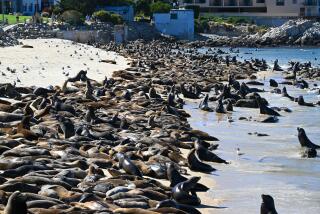Base Sets Up Landing Pads for Predators : Marines Give Hawks a Hand
- Share via
The Marines are looking for a few good hawks. So far, about 30 hawks--red-tailed and American Kestral--have congregated at the Tustin Marine Corps Air Station, which has set up a safe landing area for migratory predators.
They used to perch on power lines, cement blocks and barbed wire until Lt. Col. Robert Yaskovic, operations officer of the air station, decided to create landing pads for them.
It started about a month ago when Yaskovic rescued a male hawk that had become tangled in barbed wire. The bird died of internal parasites 5 days later, but “this injured bird made me aware of the huge bird population on the air station,” said Yaskovic, a helicopter pilot who directs the daily activities at the facility.
Beside hawks, the base birds range from herons and killdeer to barn owls, doves and sparrows.
Working with Marge Gibson, a microbiologist technician at Orange Coast College and other volunteers, Yaskovic erected 18 wooden poles for perching spots. He plans to expand that to 30.
Gibson has also begun an extensive banding process for the predatory birds, which normally fly north to Canada or the northern states his time of year, in an effort to obtain rare information about hawks in the wild.
Some hawks have not continued north after their rest, perhaps due to the Arctic storm, Yaskovic said. Surely, many would have died without the rodents they found to eat in the uncultivated fields on the base, Gibson said.
Hawks, according to Gibson, can dive at 200 m.p.h., see a mouse 1 1/2 miles away and can kill in less than a second.
“You might call this station ‘Mel’s Diner for hawks,” Yaskovic added.
It’s unnatural to have such a concentration of predatory species Gibson said, and “with the shortage of an available hunting range, they’re forced to sit shoulder to shoulder on the station. This adaptive behavior is a sign of intelligence.”
Seventy percent of all hawks die in their first year due to infant mortality and hunters, Gibson said. But Yaskovic and Gibson hope more will be saved through the Marine’s efforts. Some young hawks who have not yet heard the call of the wild, may decide to stay in Orange County, Gibson said.
The hawks, unlike gulls, make good neighbors at the helicopter base, Yaskovic said. Not only do they avoid the blades of the choppers, but, he said, they don’t complain about the noise.
Voorhees is a regular contributor to the Times Orange County Edition. Times staff writer Lynn Smith contributed to this story.
RED-TAILED HAWK
(Buteo jamaicensis)
Color: Generally brownish above and somewhat lighter below with a rufous-colored tail.
Size: About 24 inches long.
Food: Mainly rodents, but also other small mammals, birds, reptiles, amphibians and even insects.
Notes: The red-tailed hawk can be seen throughout the year, although the numbers swell in winter with the influx of northern birds. Common in open and suburban areas of Orange County, it shuns only the deepest woodlands and most heavily urbanized areas.
More to Read
Sign up for Essential California
The most important California stories and recommendations in your inbox every morning.
You may occasionally receive promotional content from the Los Angeles Times.













